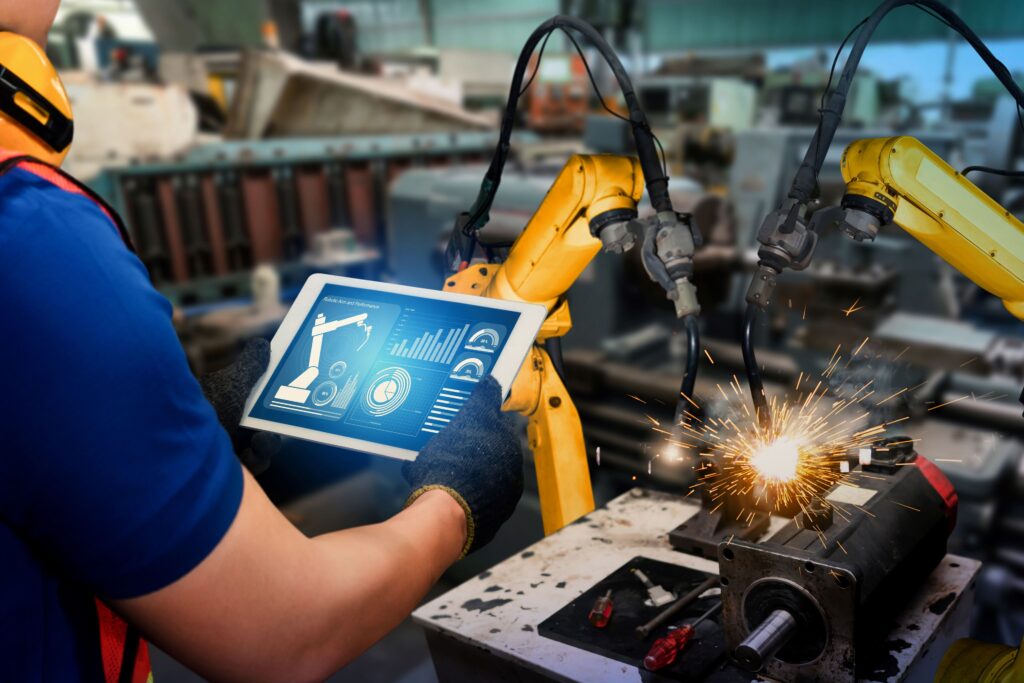Achieving maximum productivity with industrial robotics workers
Global manufacturing is facing a growing productivity paradox. While manufacturers are racing to capture retiring workers’ knowledge before they leave, using that knowledge with new technologies, including robotics, is becoming challenging because of a widening skills gap.
Nowhere is that skills gap more apparent than on the shop floor, where workflows, often decades old, must be streamlined to keep manufacturers competitive. Robotics is helping manufacturers meet that challenge worldwide. It’s important to keep robotics in context, however, and see it as an enabling technology of a broader knowledge network every manufacturer needs to cultivate and grow if they’re going to survive and thrive in the 21st century.
Sizing the manufacturing skills gap
The skills gap between worker capabilities and what manufacturers need to run their operations is growing. Gaps are the widest in the technology areas that can significantly improve shop floor accuracy, speed, and quality, with robotics being one of the most in-demand skills today. A 2021 Deloitte and Manufacturing Institute skills gap study forecasts 2.1 million unfilled U.S. manufacturing positions by 2030, potentially costing the economy $1 trillion in 2030 GDP. Globally, the World Economic Forum predicts a shortage of over 7 million skilled manufacturing workers by 2030.
Several forces are driving this talent shortage. Up to 25% of the manufacturing workforce will retire in the next decade, draining decades of expertise. At the same time, the industry is undergoing rapid digital transformation through technologies, including AI, predictive analytics, and collaborative robotics. This results in a mismatch, where just 30% of front line manufacturing workers have skills aligned to the evolving needs of manufacturing, with robotics being the most in-demand yet least available skill.
The majority of manufacturers, 83%, are struggling to attract and retain a quality workforce, according to the Deloitte and Manufacturing Institute study. 45% of manufacturers turned down opportunities due to a lack of workers. The CNN segment, Made in America is back, leaving U.S. factories scrambling to find workers, explains there are 800,000 openings despite a hiring binge last year. CNN interviewed Jay Timmons, CEO of the National Association of Manufacturers, who said, “I think we’re in uncharted territory. For every 100 job openings in the sector, we only have 60 people looking. I think it’ll take quite a while to fill that pipeline.”

What’s making targeted robotics training programs successful?
Forward-thinking manufacturers are offering their employees the opportunity to learn robotics techniques and maintenance to further their careers. One plastics manufacturer offers unlimited tuition reimbursement for robotics training and a career path into robotics operations or maintenance, depending on the employees’ preference.
The strategy is working. The plastics manufacturer runs three shifts and can scale up to run on weekends for rush jobs, offering his teams overtime pay and still achieving profitable margins on orders. By offering short-notice production runs over the weekend made more efficient with robotics, the plastics manufacturer is getting new customers as competing manufacturers in the area can’t scale that fast to support last-minute orders.
Competing with e-commerce, online retailing, and logistics providers who offer 30 – 50% higher per-hour pay rates in remote regions of the U.S. for the same skills needed on shop floors is making robotics training even more of a priority. Focused training initiatives that integrate robotics and automation skills show the potential to close the manufacturing skills gap. Employees trained in programming, operating, and maintaining robotics become better equipped for in-demand roles later in their careers.
For example:
Germany’s advanced manufacturing sector partly attributes its competitive edge to robust apprenticeship programs that develop workers’ robotics and technical abilities from an early age. Similarly, onsite training helps existing employees reskill for automated production jobs. Boeing offers virtual reality-based courses to upskill factory workers on advanced manufacturing robots and software. Studies find that these retraining programs can improve worker productivity on automated tasks by over 70%.
Getting started with robotics training
Developing in-house robotics skills doesn’t require massive investments. Companies without dedicated training facilities can still build workforce expertise in operating and optimizing robotics.
Consider the following approaches that are working for small and mid-tier manufacturers:
- Forward-thinking manufacturers invest in robotics certifications from organizations, including the Robotics Training Management Organization (RTMO) and Robotics Online. Popular options include Fanuc Handling Tool Operator Certification, Yaskawa Motoman Robot Operator Certification, and FANUC America Robot Operations.
- Covering employee costs to earn these credentials expands skills in key programming areas like motion control, maintenance, vision systems, and work cell integration. Employees become certified to code robots used on your shop floors efficiently.
- Beyond certifications, manufacturers are wise to fully fund continuous skills updating through robot OEM training courses, conferences like ATX West, and online programs. A small annual investment here can significantly boost programming productivity.
- Explore potential partnerships with local trade schools, community colleges, and universities to utilize their robotics labs and STEM programs for affordable hands-on training.
By supporting robotics certifications and ongoing education, manufacturers amplify workforce capabilities and flexibility to maximize the value of automation investments.
Here is an example of robotics in manufacturing:
Building a robotics-ready workforce
Manufacturing leaders recognize that re-skilling their workforce represents the most effective way to overcome the manufacturing skills gap. By providing production team members access to hands-on robotics education, manufacturers can unlock more value from investments in automation. Manufacturers creating defined career pathways also gain loyal, highly capable workforce.
Studies show that focused training programs integrating robotics skills can improve worker productivity on automated tasks by over 70%. Employees trained in programming, operating, and maintaining robotics equipment become better equipped for in-demand roles. Manufacturers creating defined career pathways with robotics training also gain loyal, highly capable workforce. With the widening manufacturing skills gap projected to leave over 2 million jobs unfilled in the next decade, building a robotics-ready workforce is a strategic imperative for manufacturers worldwide.
Listen to our podcast to learn more:
Continue the conversation in the DELMIA Virtual Factory and Robotics community.
